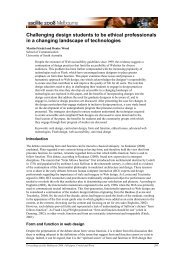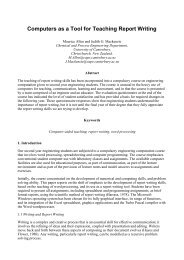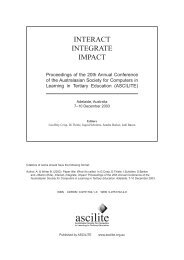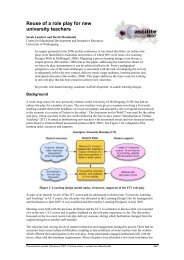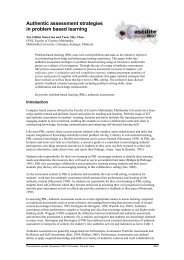Gaming frequency and academic performance - ascilite
Gaming frequency and academic performance - ascilite
Gaming frequency and academic performance - ascilite
You also want an ePaper? Increase the reach of your titles
YUMPU automatically turns print PDFs into web optimized ePapers that Google loves.
364 Australasian Journal of Educational Technology, 2008, 24(4)<br />
played three or fewer game genres (n = 516), <strong>and</strong> those who owned or played four or<br />
more genres (n = 197). A Mann-Whitney U test (applied, consistent with the above, in<br />
view of non-normal data for this section of the analysis) showed a statistically<br />
significant difference between the two groups (see Table 7) – examination results differ<br />
between gamers who play three genres or fewer, <strong>and</strong> those who play four or more. A<br />
Spearman’s correlation found a significant negative correlation (coefficient of -0.10) at<br />
the 99% level between examination results <strong>and</strong> number of genres played: gamers of<br />
four or more game genres generally perform less well in examinations.<br />
Thus, yet again, it seems that despite the reported advantages of games in terms of<br />
their ability to stimulate enhanced learning <strong>and</strong> motivation (but also bearing in mind<br />
yet again that no claim for causality is advanced here), the evidence we collected<br />
supports a negative relationship between gaming experience (with respect to<br />
engagement in various genres) <strong>and</strong> <strong>academic</strong> <strong>performance</strong>. The possible implications<br />
of these results are discussed in the concluding part of the paper, the findings calling<br />
for a more detailed analysis, since one might have expected, for example, that frequent<br />
gamers would perform better in certain specific subject areas, such as computing.<br />
Table 7: Mann-Whitney U test for the number of genres played by students<br />
Output<br />
Gamers who owned or regularly played three or fewer game genres N = 516<br />
Gamers who owned or played four or more genres N = 197<br />
Mann-Whitney U 44471.5<br />
Wilcoxon W 63974.5<br />
Z -2.584<br />
Asymp. Sig. (2-tailed) 0.010<br />
Further analyses<br />
In order to keep the data manageable for this further analysis, <strong>academic</strong> disciplines<br />
were grouped into one of six main categories broadly based on the cognate nature of<br />
the subject areas. Table 8 shows the disciplines <strong>and</strong> the number of students in each<br />
category. As above, a Spearman’s correlation test was performed to determine whether<br />
or not any statistically significant relationships existed between subject-areas <strong>and</strong><br />
gamer type. As can be seen, the results in Table 8 indicate that, despite some negative<br />
correlations, there were no significant relationships between gamer type <strong>and</strong><br />
examination <strong>performance</strong> in subject categories 1, 2, 3, <strong>and</strong> 4. However, statistically<br />
significant negative correlations (at the 95% level) were found between gamer type <strong>and</strong><br />
subject categories 5 <strong>and</strong> 6 – that is, frequent gamers perform less well in biological <strong>and</strong><br />
physical science subjects, <strong>and</strong> language studies.<br />
Despite the evidence to support a link between gaming <strong>frequency</strong> <strong>and</strong> general<br />
<strong>academic</strong> <strong>performance</strong>, it is plausible that indulging in other similar social activities<br />
may also have a bearing on examination results: spending time on any social activity,<br />
games or otherwise, might lead to similar effects. To gauge the validity of this<br />
hypothesis, students were asked: Apart from games, what is your attitude towards other<br />
forms of entertainment during busy periods of study? Here, students were presented with<br />
four categories: TV, music, cinema, <strong>and</strong> social activities (such as pubs, clubs, <strong>and</strong><br />
parties). As with the questions above, students had to specify the <strong>frequency</strong> in which<br />
they engaged in these activities during heavy study periods on a Likert scale from 1<br />
(not at all) to 4 (spend increased amount of time).



